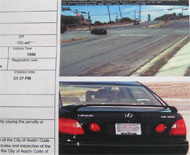7/19/2012
Florida: Traffic Camera Records Impossible SpeedsRed light cameras in St. Petersburg, Florida accuse motorist of running red light at 215 MPH.

Proponents of photo enforcement frequently assert the camera never lies, but newly released evidence suggests the technology can often be wrong. In St. Petersburg, Florida, cameras belonging to the private vendor American Traffic Solutions (ATS) have accused vehicle owners of doing the impossible. If the camera is to be believed, on December 13, 2011 at 3:29pm, a woman blasted through the intersection of 66th Street and 38th Avenue at 215 MPH.
At that velocity, her car would have been traveling the distance of an entire football field every second. Reaching such a velocity requires use of vehicles with million-dollar pricetags such as the Bugatti Veyron or Pagani Huayra or the $400,000 Lamborghini Aventador. The reading was not an isolated error. At the same location on January 8, 2012, another woman was said to have blasted through the intersection at 170 MPH. At 4th Street and 22nd Avenue, a woman allegedly hurtled through the intersection at 157 MPH on December 29, 2011.
The website St. Petersburg Red Light Cameras requested and received a log of the 21,602 photo tickets issued in the city from October 29, 2011 to April 30, 2012. Although Florida law prohibits the automated issuance of speeding tickets, all red light cameras by design incorporate some form of speed measurement so the camera can know when it should begin taking photographs.
ATS did issue other citations alleging very high speeds, but they are well within the capabilities of modern automobiles in a straight line. On April 12, 2012, a man was accused of making a right-hand turn at 96 MPH at the corner of 34th Street and 22nd Avenue. Similarly, a woman turned right at 85 MPH just three days before Christmas at the intersection of Gandy Boulevard and 4th Street.
Only 8205 tickets -- 37 percent of the total -- were issued to the owners of vehicles that allegedly committed a straight-through violation, which is the type most would consider red light running. Of these, 6905 were issued for split-second violations. That is, the car was allegedly in the intersection a fraction of a second after the light turned red. A total of 1058 tickets, 13 percent, were issued 0.1 seconds after the light turned red. Some 3638 tickets, 44 percent, were issued less than a third of a second into the red.
Opponents of red light cameras argue that if the light had stayed yellow for an additional 0.3 seconds, those violations would never have occurred.


